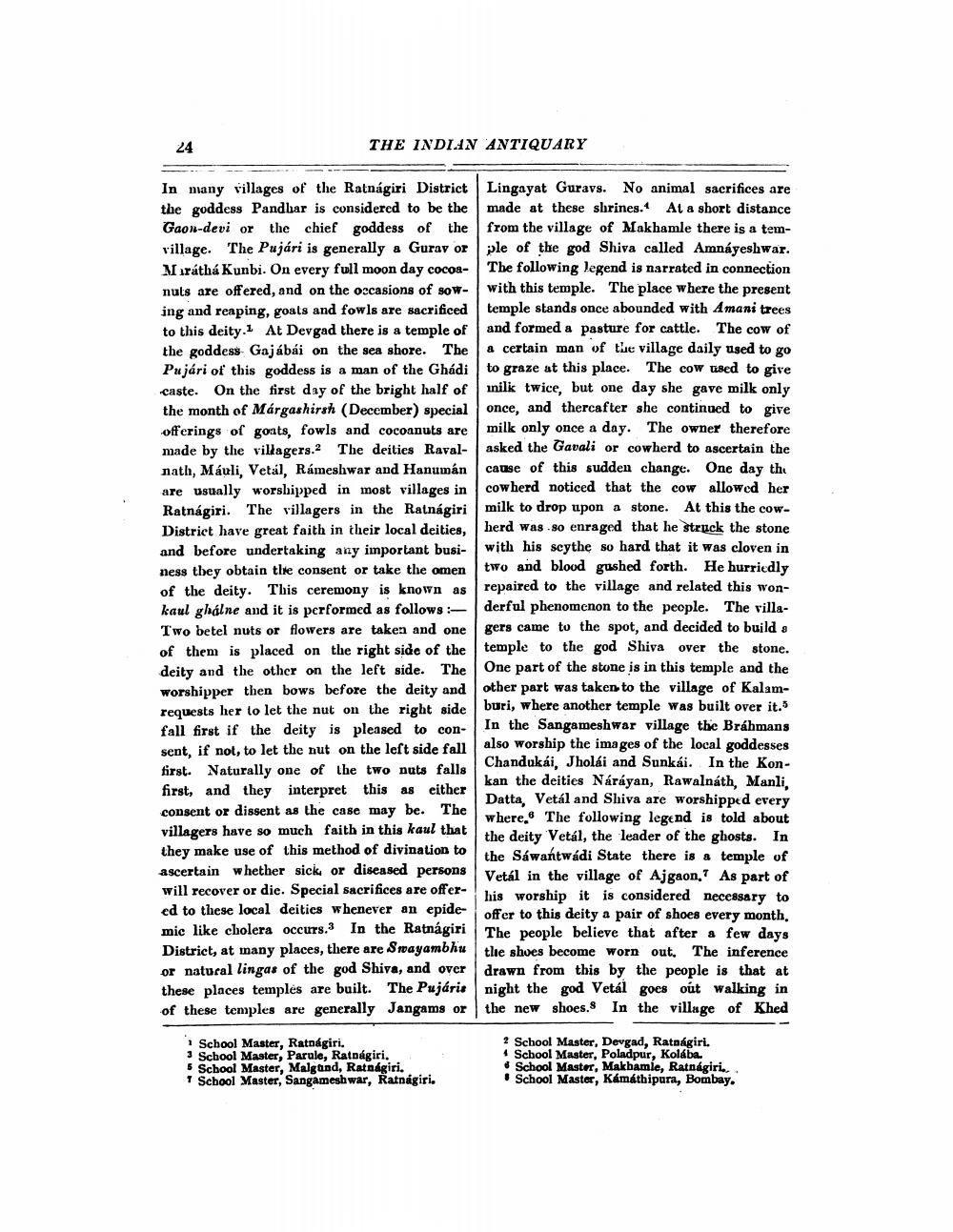________________
24
THE INDIAN ANTIQUARY
In many villages of the Ratnágiri District Lingayat Guravs. No animal sacrifices are the goddess Pandhar is considered to be the made at these shrines. At a short distance Gaon-devi or the chief goddess of the from the village of Makhamle there is a temvillage. The Pujári is generally a Gurav or ple of the god Shiva called Amnáyeshwar. Miráthá Kunbi. On every full moon day cocoa- The following legend is narrated in connection nuts are offered, and on the occasions of sow-with this temple. The place where the present ing and reaping, goats and fowls are sacrificed temple stands once abounded with Amani trees to this deity. At Devgad there is a temple of and formed a pasture for cattle. The cow of the goddess Gajábái on the sea shore. The a certain man of the village daily used to go Pujári ot' this goddess is a man of the Ghádi to graze at this place. The cow used to give caste. On the first day of the bright half of milk twice, but one day she gave milk only the month of Margashirsh (December) special once, and thercafter she continued to give offerings of goats, fowls and cocoanuts are milk only once a day. The owner therefore made by the villagers. The deities Raval- | asked the Gavali or cowherd to ascertain the nath, Máuli, Vetal, Rámeshwar and Hanumán cause of this sudden change. One day the are usually worshipped in most villages in cowherd noticed that the cow allowed her Ratnagiri. The villagers in the Ratnagiri milk to drop upon a stone. At this the cowDistrict have great faith in their local deities, herd was so enraged that he struck the stone and before undertaking any important busi- with his scythe so hard that it was cloven in ness they obtain the consent or take the omen two and blood gushed forth. He hurriedly of the deity. This ceremony is known as repaired to the village and related this wonkaul ghálne and it is performed as follows :- derful phenomenon to the people. The villaTwo betel nuts or flowers are taken and one gers came to the spot, and decided to build a of them is placed on the right side of the temple to the god Shiva over the stone. deity and the other on the left side. The One part of the stone is in this temple and the worshipper then bows before the deity and other part was taken to the village of Kalamrequests her to let the nut on the right side buri, where another temple was built over it." fall first if the deity is pleased to con
In the Sangameshwar village the Bráhmans sent, if not, to let the nut on the left side fall
also worship the images of the local goddesses first. Naturally one of the two nuts falls
Chandukái, Jholái and Sunkái. In the Kon
kan the deities Náráyan, Rawalnáth, Manli, first, and they interpret this as either
Datta, Vetál and Shiva are worshipped every consent or dissent as the case may be. The
where. The following legend is told about villagers have so much faith in this kaul that
the deity Vetál, the leader of the ghosts. In they make use of this method of divination to
the Sawantwadi State there is a temple of ascertain whether sick or diseased persons
Vetál in the village of Ajgaon,? As part of will recover or die. Special sacrifices are offer
his worship it is considered necessary to ed to these local deities whenever an epide
offer to this deity a pair of shoes every month. mic like cholera occurs. In the Ratnagiri The people believe that after a few days District, at many places, there are Swayambhu tle shoes become worn out. The inference or natural lingas of the god Shiva, and over drawn from this by the people is that at these places temples are built. The Pujáris night the god Vetál goes out walking in of these temples are generally Jangams or the new shoes. In the village of Khed
School Master, Ratnagiri. 3 School Master, Parule, Ratnagiri. 5 School Master, Malgond, Ratnagiri.
School Master, Sangameshwar, Ratnagiri.
2 School Master, Devgad, Ratnagiri. 4 School Master, Poladpur, Kolába. • School Master, Makbamle, Ratnagiri... • School Master, Kámáthipura, Bombay.




